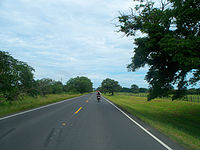National Route 1 (Costa Rica)
The road begins in the casco central (downtown, city center) districts of San José canton, just where Route 2 ends, at the east side of the La Sabana Metropolitan Park.
Inaugurated on 8 December 1972 in the government of José Figueres Ferrer in his second term (1970-1974), this segment shortened the duration of the trip from two hours to one, and the distance between San José and San Ramón by 16 kilometers, during its construction it was known as the Coco-San Ramón section, Coco corresponds to the town where the Juan Santamaría International Airport is currently located, which also had the name of El Coco International Airport in the past.
The Engineers and Architects Professional Association (CFIA) and the National Laboratory of Materials and Structural Models (LANAMME) advised against this solution since its proposal.
It wasn't until 2016 that a proper solution was put in motion, by awarding a contract to the CODOCSA company to widen the bridge from two lanes to three in each direction, which by definition involved the reconstruction of the affected joint cover.
[2] On June 26, 2012, a culvert on the La Guaria creek, near Heredia, was destroyed due to heavy rains, also it was found out that instead of proper filling on the foundations of the road when constructed in the 1960s, there were tree trunks and other organic materials that over time compacted.
[3][4] A new rectangular culvert was built by the contracted company MECO, during construction a couple of Bailey bridges with a capacity of 40 tons were put in place, which also were destroyed by an 84-ton truck crane on November 6, 2012.
In July 2019, FRU was awarded the control of the toll stations of Río Segundo and Naranjo, which provide the main income of the project.
In September 2019, Fideicomiso Ruta Uno received bids for batch 1,[8] their designs were ready by late April 2020, with a projected start date on mid May 2020.
[18] Continuing from Limonal north to Cañas, this 21 km segment started construction in September 2018, however expropriation processes delayed much of the work, which was planned to finish in 2020, pushing the delivery date to 2021.
On 11 March 2020, the project was awarded to Consorcio Ruta 1 (Hernán Solís SRL e Ingeniería Estrella S.A.), and while the other segments were constructed with concrete, this section will be made with asphalt.


